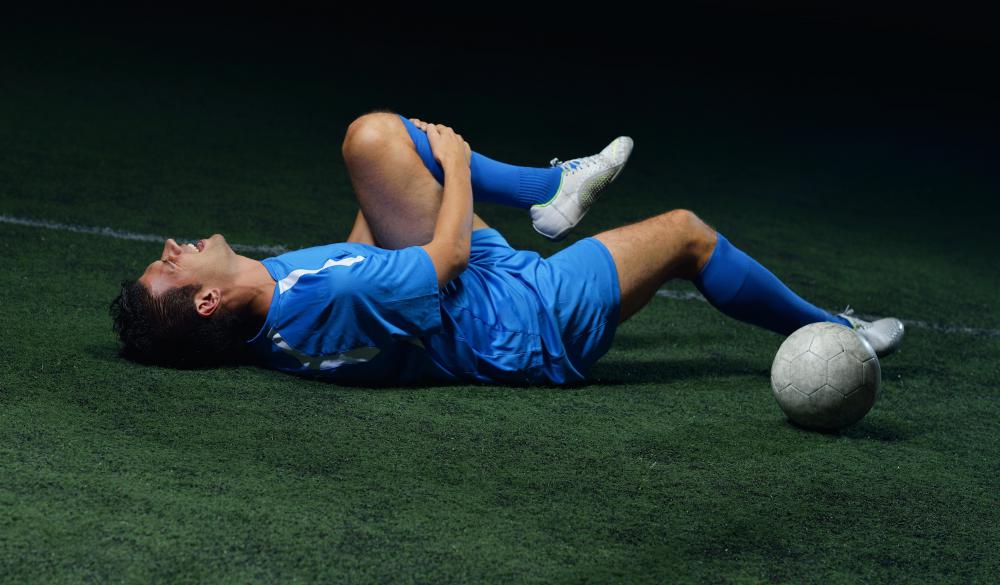At TheHealthBoard, we're committed to delivering accurate, trustworthy information. Our expert-authored content is rigorously fact-checked and sourced from credible authorities. Discover how we uphold the highest standards in providing you with reliable knowledge.
What is a High Ankle Sprain?
A high ankle sprain is a painful injury to the syndesmotic ligaments that are situated just above the ankle joint. The ligaments can become stretched or torn if a person's foot is forced to bend outward awkwardly, as is common in such sports as football and soccer. Unlike more common low ankle sprains, a high ankle sprain can take several weeks or even months to heal. Doctors usually recommend at least one month of resting and icing the leg followed by a very gradual return to physical activity to prevent further ligament damage.
The syndesmotic ligaments connect the bases of the tibia and fibula bones in the lower leg. They provide stability when walking, running, jumping, and stopping. A high ankle sprain occurs when the ligaments are suddenly stretched beyond their normal range of motion because of an awkward twist, fall, or tackle. While most ankle sprains result from the joint rolling and turning the foot inward, high ankle sprains happen when pressure forces the foot outward.

Symptoms of a high ankle sprain are usually noticeable right away. Sudden, sharp pain in the ankle and lower calf muscle can be debilitating. It may be impossible to bear weight on the leg after the injury occurs. Over the course of several days, sharp pains give way to dull, constant aches and tenderness. Significant bruising is usually present in the first few weeks, but swelling is often minimal. Depending on the severity of the injury, a person may not be able to stand up without assistance for a week or longer.

Most relatively mild high ankle sprains can be treated at home. Rest is the most important part of recovery, as the ligaments need time to heal properly. Icing the ankle, wrapping it in a protective bandage, and keeping the joint elevated during rest can help reduce pain and swelling. A person can also take over-the-counter painkillers to help with symptoms. Once the joint starts feeling better, usually in about one month, light stretching exercises can be performed to regain strength and flexibility.

If a high ankle sprain causes severe, persistent pain, it is a good idea to visit a doctor. A physician can examine the injury and take x-rays to look for signs of bone and ligament damage. If the ligaments are still intact, the patient may be prescribed high-strength painkillers, fitted with a protective wrap or brace, and given a crutch to use for at least one month. Surgery often is considered when the ligaments are seriously damaged or torn. If surgery is necessary, a patient may need to spend up to six months in a physical rehabilitation program before returning to normal physical activity.
AS FEATURED ON:
AS FEATURED ON:

















Discussion Comments
The symptoms I have are very mild, but are consistent with the descriptions here. I did not notice the symptoms at the time of injury, but instead, later the following day. I suspect that this is more of a 'strain' rather than a 'sprain'. Would an accelerated course of treatment be appropriate?
@rundocuri- If you haven't had a fall or other type of injury to your ankle, I think that it is unlikely that you have a high ankle sprain. Usually this injury is a result of a sudden, accidental movement, not from running.
In my opinion, it sounds like it could be possible that you have shin splints. This is a condition that is caused by frequent running and jogging. However, you should see a doctor for an exact diagnosis and the best treatment so that you do not make your problem worse.
Could frequent running cause a high ankle sprain? I have been having some issues in the upper portion of one of my ankles, and I run several times each week. After reading this article, I'm wondering if this could be my problem.
Post your comments